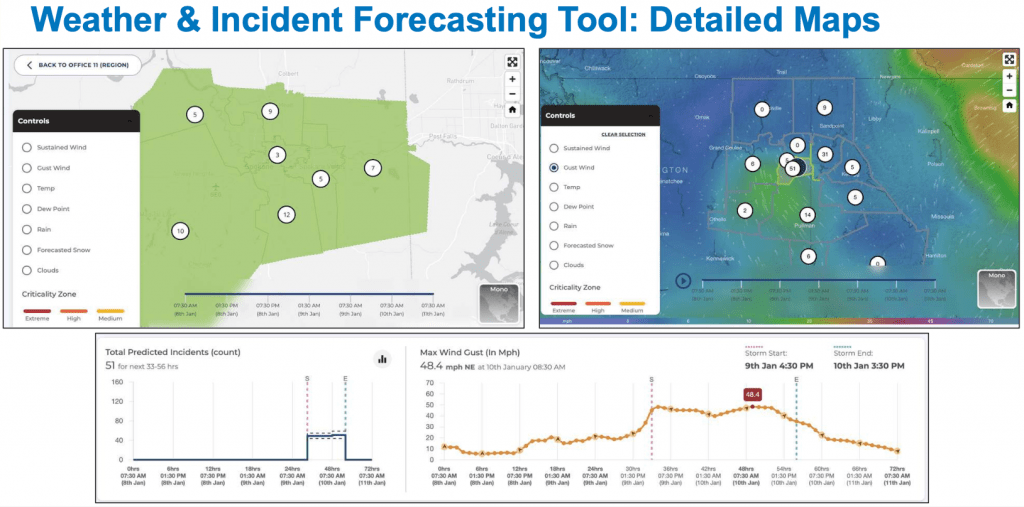Avista improves the customer experience with AI-powered weather and incident forecasting
- Avista wanted to be able to respond faster to severe weather events and communicate better with customers about those events.
- They developed a prediction model with AiDASH Climate Risk Intelligence System™ (CRIS), based on 20 years of historical weather data.
- By being proactive instead of reactive, they reduced restoration times, improved customer satisfaction, and minimized staff time during days-long restorations.
“In November of 2023, Avista had the worst gas outage in our history. We had 36,000 customers go without natural gas,” said Andrew Barrington, Products and Services Manager at Avista, at a DistribuTECH 2024 session.
Someone in their service area had ignored the age-old advice to call before you dig. “We ran all of our resources,” said Barrington. “We sent over 400 Avista personnel. We had over 800 mutual aid assistants support us in this.” In other words, it was an all-hands-on-deck situation.
Then, there was a terrible twist — a storm hit. Suddenly, in the midst of one major problem, Avista had to redirect a sizable portion of their resources to go and restore power in their Spokane, Washington, service area.
But Avista had AiDASH Climate Risk Intelligence System (CRIS), which alerted them to an oncoming storm before it landed. “Without the AiDASH system, we may have missed the storm, which would have delayed our customer response [and] our customer restoration, and ultimately [resulted in] a negative customer experience,” said Barrington.
An inability to respond fast enough to large weather events
Avista provides electricity to 406,000 customers and natural gas to about 372,000 customers across 30,000 square miles. The service area extends across all or part of Washington, Oregon, Idaho, and Montana.
The impact of wind is a significant problem for Avista. “Winds are pretty rough in our region. We know if we get winds from that northeast direction, they’re going to have much greater impact to our system versus a southwest wind,” said Barrington.
Avista did more than 500 interviews with customers, account executives, and other internal resources to get better information about how they could improve their storm responses. “The feedback we got is we weren’t communicating enough to our customers, both internal and external. And then we weren’t responsive, we weren’t prepared enough,” he said.
The utility set about determining how they could improve. They landed on the idea that perhaps they could look at historical weather data to create a predictive model that would alert them when storms were coming and help them figure out key information ahead of time. For example, they could indicate certain storm thresholds (small, medium, large) and get help figuring out what resources they would need and how long an incident response would take.
“And then we had this lightbulb moment,” said Barrington.
The path to a predictive model
“We were already in a partnership with AiDASH. They were doing our IVMS, which is their Intelligent Vegetation Management System™. So, they have all of our images of all of our trees around our distribution [lines], our transmission lines. They have all of that already built into their system,” he said.
Avista wondered if they could then take open-source weather data, filter it with historical outage data that services their region, and then build a predictive model. Such a model would tell them when a certain tree may fall and disrupt power lines, or when they might experience equipment failures.
So, they launched an MVP pilot with AiDASH CRIS. “We sent 20 years of historical storm data to AiDASH,” said Barrington. The data was specific — like how a 50-mph windstorm from the northeast looks different from one from the southwest, and the difference between wet snow and heavy snow.
When the model they were looking for emerged, it helped Avista tremendously.
“Imagine being told that, hey, you’re going to lose power 72 hours from today,” said Barrington. “You’d probably be a little bit more prepared. You could fuel up the generator. Make sure you’ve got a block of ice ready to go for the food in the refrigerator. Check on family, neighbors, all of that. And that’s exactly what Avista leveraged in this scenario.”
The utility developed thresholds to aid in evaluating the collective outage risk within specific service areas. They needed to predict storm impact and estimate storm-related incidents for 72, 48, 24, 12, and 6 hours prior to any storms.
And they did so per office in their service territory. “We have 12 offices within our region. Each one of those has their own threshold that we meet based off of historicals,” said Barrington.

That in turn enabled Avista to determine what sort of response time they could manage for any weather-related incident, how many incidents they could handle in a given amount of time, what resources a response would require, and when and how they would need to call in additional help.
In the pilot, AiDASH delivered predictions with an accuracy greater than 80%. After that success, Avista signed a 3-year contract with AiDASH and is now in a production environment.
Ahead of the storm
Instead of chasing storm-caused incidents and restoring outages as fast as they could, Avista uses CRIS to stay ahead of them. With CRIS, they can reliably predict how many incidents may happen during a major storm, and therefore how many customers would experience outages. And because they get those predictions per office, they can take tactical action ahead of time.
“Our resources are on-site, ready to go,” said Barrington. “We’re being proactive rather than reactive.”
Barrington shared a specific example — a major windstorm in January 2024. “AiDASH predicted 163 incidents for us, and we actually had 177. That 92% accuracy is just … it’s incredible,” he said.
“Being able to have that information ahead of time, we can begin proactively communicating with our customers to let them know we may experience outages, making sure they’re prepared, and then also just having our internal resources ready to go once these events happen.”
Avista’s benefits from AiDASH CRIS include:
- Improved operational efficiency (minimized need for one person to monitor weather and make decisions and gained better advance understanding of impacts on service territories).
- Decreased estimated restoration time (ERT) (achieved better planning and prep, getting the right resources in the right place at the right time).
- Improved corporate awareness and better communication across internal teams.
- Reduced costs.
- Improved SAIFI and SAIDI.
Click here for more information about our Climate Risk Intelligence System (CRIS).
AiDASH is the leader in Intelligent Sustainability Management
Ready to see it in action for yourself?
Get a demo today.
The best collection of tools, tips, guides, and industry stories – straight to your inbox.
Subscribe to our newsletter
